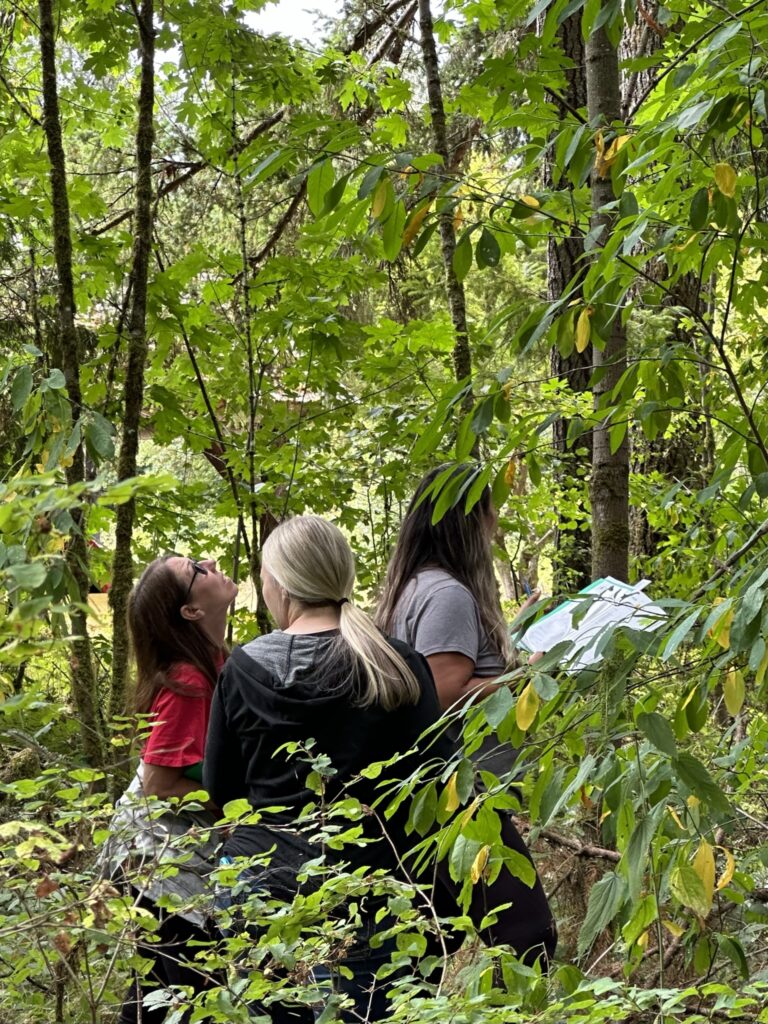Note: This photo is from an August 2023 forestry workshop.
Teachers got plenty of scientific information about trees during an urban forestry workshop in September, but what stood out to King County Urban Forestry Program Manager Joanna Nelson de Flores wasn’t the data.
“One of the highlights was the activities and discussion centered around the emotional and ecological connections to the land,” says Nelson de Flores. “I tend to wear my management hat, so it was a great reminder to build those connections through something as simple as a walk in the woods, and that young people need opportunities to make those connections.”
Nelson de Flores was one of three guest presenters at PEI’s Engaging Communities in Forest Education: Urban Forestry workshop at the Jefferson Community Center in Beacon Hill, funded through a Weyerhaeuser Giving Fund grant. She gave an overview of urban forestry and the history of land use in King County.
The workshop was a good fit for the county’s program, Nelson de Flores notes. “Ensuring that we engage youth and community in this work is one of the three main goals of our urban forestry program. We also want to make sure we’re focusing on the areas where it’s most needed. There is a big equity piece to this work.”
“One of the highlights was the activities and discussion centered around the emotional and ecological connections to the land. It was a great reminder to build those connections through something as simple as a walk in the woods, and that young people need opportunities to make those connections.”
–Joanna Nelson de Flores, King County Urban Forestry Manager
Ali Lakehart, Program Manager of Trees for Seattle, was another guest presenter. Trees for Seattle is an umbrella organization covering all of the city of Seattle’s urban forestry efforts, including the Trees for Neighborhoods program which plants free trees with residents, churches, businesses, and schools on their property. “Connecting with teachers helps us spread the word about this incredible opportunity,” says Lakehart. “I enjoyed meeting all the teachers and hearing more about their lens on our urban flora and fauna and how to get students engaged.”
Teachers from eight King and Snohomish County school districts learned about strategies and resources for integrating urban forestry education into curricular programming and practice, with an emphasis on environmental justice and forestry career pathways. They received an overview of locally relevant urban forestry projects and initiatives in Seattle and King County, explored an urban forest, participated in Project Learning Tree activities, and learned about tools like iTree, MyTree, and iCanopy.
They also considered forests through the lens of emotional and ecological connections. Guest presenter Shameka Gagnier is the creator of Futures Rising, an organization that centers connecting plant communities to their usual and accustomed territories, coordinating or working with BIPOC youth job training education cohorts and events, leading place-making and restoration events, writing curriculum, and teaching project-based arts integrative education.
“A lot of participants really connected with the social and emotional benefits of nature,” says PEI’s East Sound FieldSTEM Coordinator Lydia Geschiere, the workshop’s facilitator. “They were excited about ideas and activities that gave students time to be with trees and think about their value through different lenses.”
Participants also considered how environmental justice factors into urban forestry. Geschiere showed educators how to use the U.S. Environmental Protection Association’s Environmental Justice Screening and Mapping Tool (EJSCREEN + EJAtlas) to explore and map environmental justice issues in communities.
“We talked about the heat island effect and what it means for some people to have access to green spaces while others don’t,” Geschiere explains. “There are metrics students can use to see how far various groups of people live from green spaces on the one hand or incinerators on the other. We had a conversation around who gets the benefits of the environment and who gets the burdens of things we all do.”
The workshop culminated in a visit to Cheasty Greenspace, a multi-use 43-acre urban forest restored to its current state through the collaborative work of multiple volunteers and organizations. “A lot of cooperation had to go into making this space happen,” Geschiere points out. “We talked about what it looks like to make decisions for different spaces and looked at how they could use urban forestry tools to talk about tree benefits and tree canopy with their students.”
Because participants came from a range of districts, they considered ways to adapt what they were learning to their region. “We had people from rural/suburban areas as well as urban ones,” says Nelson de Flores. “People were talking about how to adjust some of the ideas and concepts to the different landscapes and situations that each community is facing.”
One thing they had in common: a shared dedication to outdoor learning. “The teachers felt passionately that getting students outside for their wellbeing is very important right now,” says Geschiere, “and they were excited about finding entry points into doing that.”
